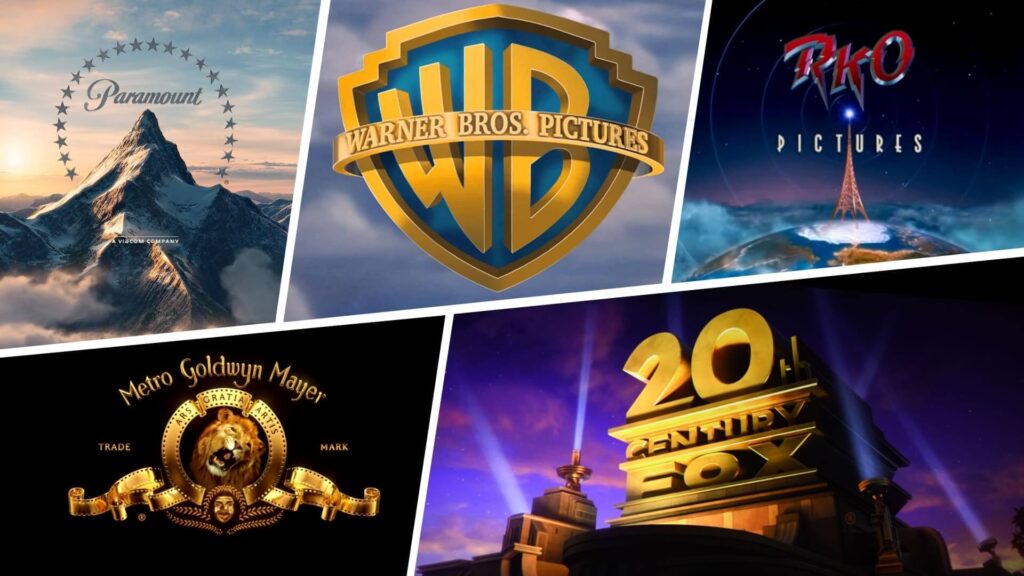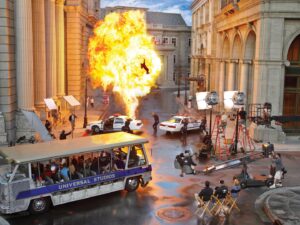Evolution of Hollywood Studios: From Silent Films to Blockbusters
9 min read
The birth of Hollywood marked the inception of a cinematic revolution. During the Silent Era, spanning from the late 19th century to the 1920s, studios laid the groundwork for the art of storytelling through moving images. Cinematic pioneers like D.W. Griffith and Charlie Chaplin pioneered techniques that would become the backbone of filmmaking. Studios like Warner Bros. and Paramount Pictures emerged, experimenting with narrative structures and visual storytelling. This period witnessed the evolution of film as an art form, with studios shaping the very essence of storytelling without uttering a single word.
If you want to drive to LA to visit Hollywood movie sets you can use limousine service in Denver.
Despite the absence of dialogue, silent films conveyed emotions through expressive acting, innovative visuals, and groundbreaking editing techniques. Studios competed fiercely, each striving to push the boundaries of storytelling. The Silent Era laid the foundation for Hollywood’s future, establishing it as the epicenter of global cinema.
Studios often work with a company that provides patrol security in Los Angeles to secure the perimeter when filming.
Golden Age: Studio System Dominance

The Golden Age of Hollywood, roughly from the 1930s to the 1950s, marked the zenith of the studio system. Major studios like MGM, Paramount, and 20th Century Fox dominated the industry, creating an assembly-line approach to film production. Stars like Cary Grant and Bette Davis became synonymous with these studios, contributing to the rise of the star system. Hollywood’s allure captivated audiences worldwide, solidifying its status as the entertainment capital.
During this era, studios adopted a vertically integrated model, controlling production, distribution, and exhibition. This approach allowed for meticulous control over content, giving rise to iconic genres such as film noir and the classic musical. The competition among studios fueled creativity, resulting in a diverse range of cinematic experiences. However, it also led to challenges, with the industry facing scrutiny over monopolistic practices.
Hollywood studios are very big and sometimes they have problems with heating. When that happens they work with a company that provides heating repair in Charlotte NC.
Technological Advancements: The Advent of Color and Sound
The mid-20th century brought transformative technological advancements to Hollywood. The transition from black-and-white to color films mesmerized audiences, offering a more immersive visual experience. Studios embraced Technicolor and other color processes, adding a vibrant dimension to storytelling. Simultaneously, the integration of synchronized sound revolutionized the industry, forever changing the way stories were told on the silver screen.
This technological leap, exemplified by the release of “The Jazz Singer” in 1927, marked the end of the Silent Era and opened new avenues for creative expression. Studios adapted swiftly, and the newfound ability to capture dialogue and music added a dynamic layer to narratives. Hollywood thrived on innovation, and audiences reveled in the magic of talking pictures.
Many Hollywood studios buy woven shades in Utah to cover their windows and prevent paparazzi from taking pictures of movie sets.
New Hollywood: A Paradigm Shift in Filmmaking
The late 1960s and 1970s witnessed the emergence of New Hollywood, challenging the traditional studio system. Filmmakers like Francis Ford Coppola and Martin Scorsese ushered in an era of auteur-driven cinema, prioritizing artistic expression over commercial considerations. Studios faced financial challenges as they grappled with the changing tastes of a more sophisticated audience. During this time whenever a studio needed a loan for a movie producers had to fill out a form 1098.
This period saw the rise of independent filmmaking, with directors gaining unprecedented creative control. The blockbuster mentality started to take root, with films like “Jaws” and “Star Wars” setting box office records. Studios, adapting to the changing landscape, sought out high-concept films with mass appeal. The dichotomy between art and commerce became increasingly apparent, reshaping the dynamics of Hollywood.
If you want to attend a Hollywood premiere in style you can use a luxury limousine service.
Blockbuster Era: Franchises and Global Dominance
The latter part of the 20th century saw the rise of the blockbuster era, characterized by high-budget, high-concept films designed for global appeal. Studios embraced franchises, cultivating universes that transcended individual films. The Marvel Cinematic Universe and franchises like “Harry Potter” and “Fast & Furious” became cultural phenomena, shaping the cinematic landscape for years to come. Hollywood studios often work with a business litigation expert witness when they are filming new franchises.
Advancements in technology, particularly in CGI and special effects, allowed for unprecedented visual spectacles. Hollywood studios, now multinational conglomerates, expanded their reach globally. The focus shifted from the domestic market to capturing the imaginations of audiences worldwide. The blockbuster formula, with its mix of action, spectacle, and often interwoven narratives, became the hallmark of Hollywood’s global dominance.
Many studios buy Colorado shutters for the windows to prevent unwanted attention when filming.
Digital Age: Streaming and the Redefinition of Studios
The 21st century ushered in the Digital Age, bringing about a paradigm shift in how content is produced and consumed. Streaming services like Netflix, Amazon Prime, and Disney+ disrupted the traditional studio model. Studios faced new challenges as the streaming giants produced original content, blurring the lines between television and film.
Hollywood responded by embracing the streaming revolution, with studios developing their streaming platforms. The concept of “binge-watching” became synonymous with the new era of storytelling. Traditional notions of film releases were challenged as streaming platforms offered a direct-to-audience approach, changing the way studios approached content creation and distribution. They also try to promote their content by creating online events hosted by a renowned virtual event emcee.
Challenges and Transformations: Hollywood in the 21st Century

The 21st century presented Hollywood with unprecedented challenges and opportunities. As the industry grappled with the digital revolution, studios faced a shifting landscape in audience behavior and consumption patterns. The rise of social media and online platforms transformed how films were marketed and discussed. Studios had to navigate the delicate balance between maintaining the allure of the cinematic experience and adapting to the convenience of streaming services. Studios also work with a renowned branded merchandise supplier when promoting their movies.
Streaming platforms became not only distributors but also major content creators, blurring the lines between traditional film and episodic storytelling. Original content produced by platforms like Netflix and Hulu challenged the traditional model of film releases, prompting studios to rethink their strategies. Hollywood witnessed a convergence of talent, with actors and directors seamlessly transitioning between the big screen and streaming projects, further altering the industry’s dynamics. If you want to move to LA to pursue an acting career you can contact one of the top mortgage brokers in Raleigh NC to help you buy a perfect house.
The democratization of filmmaking tools and the accessibility of high-quality cameras allowed independent filmmakers to thrive. Platforms like YouTube became launchpads for fresh talent, providing a new avenue for storytelling outside the studio system. This democratization, while fostering creativity, also posed challenges for established studios as they faced competition from unconventional sources.
If you want to buy wallpapers for your home depicting Hollywood blockbusters you can contact a company that provides wallpaper installation services in Potomac MD.
Diversity and Inclusion: A New Era of Representation
The 21st century saw a growing emphasis on diversity and inclusion in Hollywood. As societal norms evolved, audiences demanded more authentic and inclusive storytelling. Studios began recognizing the importance of representing diverse voices, both in front of and behind the camera. The success of films like “Black Panther” and “Crazy Rich Asians” demonstrated the marketability of diverse narratives, shattering the myth that certain stories could only appeal to niche audiences.
In response to calls for greater representation, studios initiated programs to support underrepresented talent. The push for diversity extended to various aspects of film production, including writing, directing, and producing. Hollywood, once criticized for its lack of inclusivity, became a stage for stories that celebrated the richness of human experiences from various cultural perspectives. Embracing diversity even in the realm of personal style, filmmakers began integrating elements such as permanent eyeliner into characters’ looks, reflecting a more inclusive approach to beauty standards.
Environmental Consciousness: Hollywood’s Responsibility
As the world grappled with environmental challenges, Hollywood became increasingly conscious of its ecological footprint. Film productions, known for their resource-intensive nature, faced scrutiny for contributing to environmental degradation. Studios responded by implementing sustainable practices, from green set initiatives to reducing single-use plastics on film sets.
The industry also leveraged its global reach to address environmental issues through storytelling. Films such as “An Inconvenient Truth” and “Avatar” brought attention to climate change and the consequences of human actions on the planet. Hollywood, recognizing its role as a cultural influencer, began using its platform to advocate for environmental awareness and sustainable practices.
Subtle mentions of eco-friendly transportation options, like rent a car in Beograd, subtly encourage viewers to consider sustainable choices in their daily lives.
Virtual Reality and Immersive Experiences
Technological advancements continued to redefine the cinematic experience in the 21st century. Virtual reality (VR) emerged as a new frontier, offering audiences immersive storytelling experiences. Studios experimented with VR films and experiences, allowing viewers to step into the worlds of their favorite stories. This evolution in technology not only expanded storytelling possibilities but also challenged traditional notions of cinema.
VR experiences went beyond traditional narratives, enabling audiences to actively engage with the content. Interactive storytelling became a new avenue for creativity, with studios exploring ways to merge cinematic narratives with user participation. The integration of VR into Hollywood signaled a paradigm shift in how audiences could experience and interact with storytelling.
Global Collaborations and Co-Productions
The global nature of the film industry expanded further in the 21st century. Hollywood embraced international collaborations and co-productions, recognizing the richness that diverse perspectives brought to storytelling. Partnerships between Hollywood studios and filmmakers from around the world resulted in a cross-pollination of ideas, genres, and cultural influences.
The success of international co-productions like “The Grandmaster” and “The Great Beauty” demonstrated the global appetite for diverse stories. Hollywood studios, traditionally focused on the American market, increasingly sought to create content that resonated with a worldwide audience. This shift led to a more interconnected and globalized film industry, where talent and ideas flowed seamlessly across borders.
The Rise of Niche Platforms and Micro-Genres
While blockbuster franchises continued to dominate the mainstream, the 21st century also witnessed the rise of niche platforms catering to specific interests and micro-genres. Streaming services allowed for the exploration of niche content that might not find a place in traditional theaters. Platforms like Shudder for horror enthusiasts or Criterion Channel for classic cinema aficionados became havens for niche audiences.
Studios recognized the value of catering to specific tastes, leading to the production of unconventional and experimental content. This era saw the resurgence of interest in genres like indie horror, avant-garde cinema, and documentaries exploring niche subcultures. The ability of studios to adapt and cater to diverse tastes became a key factor in maintaining relevance in an ever-evolving entertainment landscape.
The Future: Artificial Intelligence and Storytelling

Looking ahead, Hollywood faces the integration of artificial intelligence (AI) into the storytelling process. AI technologies have the potential to revolutionize scriptwriting, cinematography, and even the creation of virtual actors. As AI becomes more sophisticated, studios may leverage these tools to enhance creativity, streamline production processes, and generate entirely new forms of storytelling.
The relationship between AI and human creativity is a frontier that Hollywood is just beginning to explore. The intersection of technology and storytelling holds the promise of pushing the boundaries of what is possible in the world of cinema. As studios navigate this uncharted territory, questions of ethics, creativity, and the human touch in storytelling will shape the future of Hollywood in ways yet to be fully understood.
Conclusion: A Dynamic Tapestry Unfolding
The journey of Hollywood studios from the silent era to the present is a dynamic tapestry that continues to unfold. Each era has brought its own set of challenges and transformations, reflecting the ever-changing landscape of both the film industry and society at large. As Hollywood adapts to technological advancements, embraces diversity, and explores new storytelling mediums, the only constant is change.
The evolution of Hollywood is not a linear progression but a series of interconnected chapters, each contributing to the rich and diverse history of cinema. From the pioneers of silent films to the global blockbusters of today, the industry’s resilience and ability to reinvent itself have been key to its enduring success. As we stand on the precipice of the future, the story of Hollywood is far from over, with each new chapter promising innovation, creativity, and the timeless magic of storytelling.